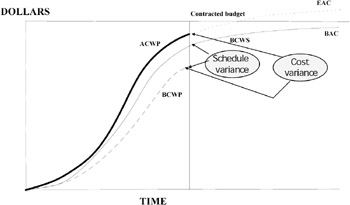What is cost variance?
|
Cost variance (CV) is the amount of money that was actually spent on a project or a part of a project compared to the amount of work that was actually accomplished. Cost variance is the budgeted cost of work performed minus the actual cost of work performed.
![]()
Tell me more …
In the earned value reporting system for projects, we are concerned with knowing how our project is doing with respect to the amount of money being spent and the accomplishments being achieved. The measure for this comparison is the cost variance.
To compute the cost variance, we compare the work that was actually completed to the actual amount spent to accomplish it. This means that we will be comparing the budgeted cost of work performed, the BCWP, with the actual cost of work performed, the ACWP (see Figure 10-4).

Figure 10-4: EARNED VALUE REPORT
People always have trouble remembering these things. They get them mixed up and end up having a positive variance when they are really having a negative variance. It is good to remember that bad variances are always negative and good variances are always positive. If we consider that completed project tasks have an actual cost that is less than what was planned for, we could say that this is a good variance and it should have a positive value. If, on the other hand, we have spent more to accomplish our tasks than the plan allowed for, we could say that this is a bad condition and our variance will be a negative number. Of course "good" and "bad" must be qualified. Just because we have a positive cost variance does not always mean something good. If our cost variance is positive and we have left out some of the required work it would not be such a good thing. A good rule of thumb is that any variances, whether positive or negative, should be investigated.
The cost variance is an important figure to the project manager and the other managers of the company because it is an indicator of how well the project is doing in terms of spending its budget. It can be used to predict or forecast how much money it will cost to finish the project.
Suppose a project is in progress and that as of today the ACWP is $190,000, the BCWP is $210,000 and the BCWS is $200,000. What is the cost variance?
Cost variance is the difference between the work that was really accomplished, the BCWP, and the cost of doing the work, the ACWP.
![]()
|
EAN: 2147483647
Pages: 126